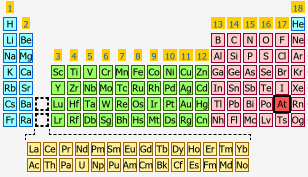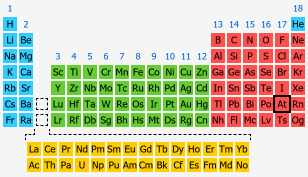References (Click the  next to a value above to see complete citation information for that entry)
next to a value above to see complete citation information for that entry)
Andersen, T., H. K. Haugen, and H. Hotop. "Binding Energies in Atomic Negative Ions: III." Journal of Physical and Chemical Reference Data, volume 28, number 6, 1999, pp. 1511–1533.
Journal of Physical and Chemical Reference Data, volume 28, number 6, 1999, pp. 1511–1533.
Ball, David W. "Elemental Etymology: What's in a Name?" Journal of Chemical Education, volume 62, number 9, 1985, pp. 787–788. doi:10.1021/ed062p787
Bratsch, Steven G. "Revised Mulliken Electronegativities: I. Calculation and Conversion to Pauling Units." Journal of Chemical
Education, volume 65, number 1, 1988, pp. 34–41. doi:10.1021/ed065p34
Campbell, J. L. "Fluorescence Yields and Coster–Kronig Probabilities for the Atomic L Subshells. Part II: The L1 Subshell Revisited." Atomic
Data and Nuclear Data Tables, volume 95, number 1, 2009, pp. 115–124. doi:10.1016/j.adt.2008.08.002
Campbell, J. L. "Fluorescence Yields and Coster–Kronig Probabilities for the Atomic L Subshells." Atomic Data and Nuclear Data Tables,
volume 85, number 2, 2003, pp. 291–315. doi:10.1016/S0092-640X(03)00059-7
Clementi, E., D. L. Raimondi, and W. P. Reinhardt. "Atomic Screening Constants from SCF Functions. II. Atoms with 37 to 86 Electrons." Journal of Chemical Physics, volume 47, number 4, 1967, pp. 1300–1307. doi:10.1063/1.1712084
Cohen, E. Richard, David R. Lide, and George L. Trigg, editors. AlP Physics Desk Reference, 3rd edition. New York:
Springer-Verlag New York, Inc., 2003.
Connelly, Neil G., Ture Damhus, Richard M. Hartshorn, and Alan T. Hutton. Nomenclature of Inorganic Chemistry: IUPAC Recommendations 2005. Cambridge: RSC Publishing, 2005.
Cambridge: RSC Publishing, 2005.
Cordero, Beatriz, Verónica Gómez, Ana E. Platero-Prats, Marc Revés, Jorge Echeverría, Eduard Cremades, Flavia Barragán, and Santiago Alvarez. "Covalent Radii Revisited." Dalton Transactions, number 21, 2008, pp 2832–2838. doi:10.1039/b801115j
Corson, D. R., K. R. MacKenzie, and E. Segrè. "Artificially Radioactive Element 85." Physical Review, volume 58, number 8, 1940, pp. 672–678. doi:10.1103/PhysRev.58.672
Cox, P. A. The Elements: Their Origin, Abundance and Distribution. Oxford: Oxford University Press, 1989.
de Podesta, Michael. Understanding the Properties of Matter, 2nd edition. London: Taylor & Francis, 2002.
Dronskowski, Richard. Computational Chemistry of Solid State Materials. Weinheim, Germany: WILEY-VCH Verlag GmbH & Co. KGaA, 2005.
Ebbing, Darrell D., and Steven D. Gammon. General Chemistry, 8th edition. Boston, MA: Houghton Mifflin Company, 2005.
Emsley, John. Nature's Building Blocks: An A-Z Guide to the Elements. Oxford: Oxford University Press, 2003.
Emsley, John. The Elements, 3rd edition. Oxford: Oxford University Press, 1998.
Firestone, Richard B. Table of Isotopes,
8th edition, volume 2. Edited by Virginia S. Shirley, with assistant editors Coral M. Baglin, S. Y. Frank Chu, and Jean Zipkin. New York: John Wiley & Sons, Inc., 1996.
Greenwood, N. N., and A. Earnshaw. Chemistry of the Elements, 2nd edition. Oxford: Butterworth-Heinemann, 1997.
Gwyn Williams. Electron Binding Energies. http://www.jlab.org/~gwyn/ebindene.html . Accessed on April 30, 2010.
. Accessed on April 30, 2010.
Ho, C. Y., R. W. Powell, and P. E. Liley. "Thermal Conductivity of the Elements: A Comprehensive Review." Journal of Physical and Chemical Reference Data, volume 3, supplement 1, 1974, pp. I–1 to I–796.
Journal of Physical and Chemical Reference Data, volume 3, supplement 1, 1974, pp. I–1 to I–796.
Horvath, A. L. "Critical Temperature of Elements and the Periodic System." Journal of Chemical Education, volume 50, number 5, 1973, pp. 335–336. doi:10.1021/ed050p335
Huheey, James E., Ellen A. Keiter, and Richard L Keiter. Inorganic Chemistry: Principles of Structure and Reactivity, 4th edition. New York: HarperCollins College Publishers, 1993.
Ihde, Aaron J. The Development of Modern Chemistry. New York: Dover Publications, Inc., 1984.
Jr., Elbert J. Little,, and Mark M. Jones. "A Complete Table of Electronegativities." Journal of Chemical Education, volume 37, number 5, 1960, pp. 231–233. doi:10.1021/ed037p231
Liboff, Richard L. Introductory Quantum Mechanics, 3rd edition. Reading, MA: Addison Wesley Longman, Inc., 1998.
Lide, David R., editor. CRC Handbook of Chemistry and Physics, 88th edition. Boca Raton, Florida: Taylor & Francis Group, 2008.
Mann, Joseph B., Terry L. Meek, and Leland C. Allen. "Configuration Energies of the Main Group Elements." Journal of the American Chemical Society, volume 122, number 12, 2000, pp. 2780–2783. doi:10.1021/ja992866e
Marshall, James L. Discovery of the Elements: A Search for the Fundamental Principles of the Universe, 2nd edition. Boston, MA: Pearson Custom Publishing, 2002.
Martin, W. C. "Electronic Structure of the Elements." The European Physical Journal C — Particles and Fields, volume 15, number 1–4, 2000, pp. 78–79. doi:10.1007/BF02683401
Miessler, Gary L., and Donald A. Tarr. Inorganic Chemistry, 3rd edition. Upper Saddle River, NJ: Pearson Prentice Hall, 2004.
Nagle, Jeffrey K. "Atomic Polarizability and Electronegativity." Journal of the American Chemical Society, volume 112, number 12, 1990, pp. 4741–4747. doi:10.1021/ja00168a019
Oxtoby, David W., H. P. Gillis, and Alan Campion. Principles of Modern Chemistry, 6th edition. Belmont, CA: Thomson Brooks/Cole, 2008.
Pauling, Linus. The Nature of the Chemical Bond, 3rd edition. Ithaca, NY: Cornell University Press, 1960.
Pekka Pyykkö. Self-Consistent, Year-2009 Covalent
Radii. http://www.chem.helsinki.fi/~pyykko/Radii09.pdf . Accessed on November 20, 2010.
. Accessed on November 20, 2010.
Perrier, C., and E. Segrè. "Some Chemical Properties of Element 43." Journal of Chemical Physics, volume 5, number 9, 1937, pp. 712–716. doi:10.1063/1.1750105
Pyykkö, Pekka, and Michiko Atsumi. "Molecular Double-Bond Covalent Radii for Elements Li-E112." Chemistry - A European Journal,
volume 15, number 46, 2009, pp. 12770–12779. doi:10.1002/chem.200901472
Pyykkö, Pekka, and Michiko Atsumi. "Molecular Single-Bond Covalent Radii for Elements 1-118." Chemistry - A European Journal,
volume 15, number 1, 2009, pp. 186–197. doi:10.1002/chem.200800987
Pyykkö, Pekka, Sebastian Riedel, and Michael Patzschke. "Triple-Bond Covalent Radii." Chemistry - A European Journal,
volume 11, number 12, 2005, pp. 3511–3520. doi:10.1002/chem.200401299
Quadbeck-Seeger, Hans-Jürgen. World of the Elements: Elements of the World. Translated by José Oliveira. Bad Dürkheim, Germany:
Wiley-VCH Verlag GmbH & Co. KGaA, 2007.
Rothe, S., A. N. Andreyev, S. Antalic, A. Borschevsky, L. Capponi, T. E. Cocolios, H. De Witte, E. Eliav, D. V. Fedorov, V. N. Fedosseev, D. A. Fink, S. Fritzsche, L. Ghys, M. Huyse, N. Imai, U. Kaldor, Yuri Kudryavtsev, U. Köster, J. F. W. Lane, J. Lassen, V. Liberati, K. M. Lynch, B. A. Marsh, K. Nishio, D. Pauwels, V. Pershina, L. Popescu, T. J. Procter, D. Radulov, S. Raeder, M. M. Rajabali, E. Rapisarda, R. E. Rossel, K. Sandhu, M. D. Seliverstov, A. M. Sjödin, P. Van den Bergh,
P. Van Duppen, M. Venhart, Y. Wakabayashi, and K. D. A. Wendt. "Measurement of the First Ionization Potential of Astatine by Laser Ionization Spectroscopy." Nature Communications, volume 4:1835, 2013, pp. 1–6. doi:10.1038/ncomms2819
Nature Communications, volume 4:1835, 2013, pp. 1–6. doi:10.1038/ncomms2819
Shannon, R. D. "Revised Effective Ionic Radii and Systematic Studies of Interatomic Distances in Halides and Chalcogenides." Acta Crystallographica Section A, volume 32, number 5, 1976, pp. 751–767. doi:10.1107/S0567739476001551
Silbey, Robert J., Robert A. Alberty, and Moungi G. Bawendi. Physical Chemistry, 4th edition. Hoboken, NJ: John Wiley & Sons, Inc., 2005.
Soukhanov, Anne H., editor. The American Heritage Dictionary Of The English Language, 3rd edition. Boston: Houghton Mifflin Company, 1992.
Waber, J. T., and Don T. Cromer. "Orbital Radii of Atoms and Ions." Journal of Chemical Physics, volume 42, number 12, 1965, pp. 4116–4123. doi:10.1063/1.1695904
Waldron, Kimberley A., Erin M. Fehringer, Amy E. Streeb, Jennifer E. Trosky, and Joshua J. Pearson. "Screening Percentages Based on Slater Effective Nuclear Charge as a Versatile Tool for Teaching Periodic Trends." Journal of Chemical Education, volume 78, number 5, 2001, pp. 635–639. doi:10.1021/ed078p635
Weeks, Mary Elvira, and Henry M. Leicester. Discovery of the Elements, 7th edition. Easton, PA: Journal of Chemical Education, 1968.
Yaws, Carl L. The Yaws Handbook of Physical Properties for Hydrocarbons and Chemicals. Houston, TX: Gulf Publishing Company, 2005.















































 next to a value above to see complete citation information for that entry)
next to a value above to see complete citation information for that entry) Journal of Physical and Chemical Reference Data, volume 28, number 6, 1999, pp. 1511–1533.
Journal of Physical and Chemical Reference Data, volume 28, number 6, 1999, pp. 1511–1533.




 Cambridge: RSC Publishing, 2005.
Cambridge: RSC Publishing, 2005.

 . Accessed on April 30, 2010.
. Accessed on April 30, 2010. Journal of Physical and Chemical Reference Data, volume 3, supplement 1, 1974, pp. I–1 to I–796.
Journal of Physical and Chemical Reference Data, volume 3, supplement 1, 1974, pp. I–1 to I–796.




 . Accessed on November 20, 2010.
. Accessed on November 20, 2010.



 Nature Communications, volume 4:1835, 2013, pp. 1–6. doi:10.1038/
Nature Communications, volume 4:1835, 2013, pp. 1–6. doi:10.1038/





